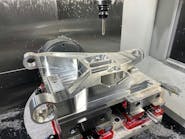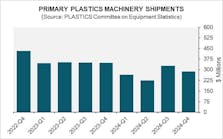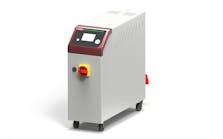Japan Steel Works' (JSW) multiyear rollout of new injection molding machines has hit another milestone, as the Tokyo-based company introduced the smallest models in its all-electric JADS line.
The series, which is replacing the JAD line in stages, boasts new controls and software, as well as upgrades to the barrel and improved control over nozzle touch force.
"This model is pretty much the newest update we've done in the last eight years," said Joe Lombardo, assistant sales manager for Japanese accounts at the company's Lake Zurich, Ill., location.
"Our last machine was an extremely robust machine. I have a feeling you could have dropped it from a crane, and it would still run. … But now, we've upped the bells and whistles."
After showing off a prototype of a JADS machine at NPE2015, JSW launched its first commercial models in the line last year, with the debut of four machines with clamping forces ranging from about 243 tons to 496 tons. This year, it's more than doubled the number of offerings, with six new models ranging from about 34 tons to 202 tons. So far, all the JADS machines are horizontally aligned, but Lombardo said the company plans to introduce vertical JADS machines next year. The rollout will conclude in about 2019, with the replacement of the biggest JAD models.
Depending on their size, the JADS machines are well-suited for manufacturing a wide range of products, from toothbrushes to automotive parts. They have high repeatability and precision, Lombardo said.
Compared to their predecessors, the JADS machines sport narrower barrels. The company, which makes its own steel, has compressed the metal, resulting in about a 20 percent reduction in barrel diameter, he said.
"So it's a little easier to start up, and it takes less energy," he said. Other than the barrels, the structural components of the machines are guaranteed for 10 years.
In another improvement on the JAD design, the JADS series has gained an Android-based interface. Using the interface and onboard software, operators can access data from sensors, and upload screenshots, pictures, questions or instructions for coworkers. A preventive maintenance program provides information about the condition of various components, and walks operators through issues so they can easily diagnose and troubleshoot problems.
In its "Eco-Friendly" mode, the interface also suggests ways to save energy.NET100, a software option that Lombardo described as fairly inexpensive, allows users to link the machines together via a server. In this way, they can monitor operations, and even make changes from smart phones or other devices.
Other upgrades to the series include the addition of support beams to provide stability and balance to nozzle movements.
"This machine also has guide bars, along with the tie bars, so it has less friction," he said.
Machines in the new series, including its most popular version, the versatile 496-tonner, are available in stock in the U.S.
Karen Hanna, copy editor
khanna@plasticsmachinerymagazine.com
Contact:
JSW Plastic Machinery Inc.Lake Zurich, Ill., 847-550-0704, www.jswpmi.com
Karen Hanna | Senior Staff Reporter
Senior Staff Reporter Karen Hanna covers injection molding, molds and tooling, processors, workforce and other topics, and writes features including In Other Words and Problem Solved for Plastics Machinery & Manufacturing, Plastics Recycling and The Journal of Blow Molding. She has more than 15 years of experience in daily and magazine journalism.





